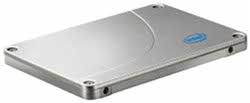Intel SSD uses two-inch mSATA form factor
Dec 29, 2010 — by Eric Brown — from the LinuxDevices Archive — 5 viewsIntel Corp. announced a solid state drive (SSD) in 40GB or 80GB capacities, claimed to be an eighth the size of the company's 2.5-inch X25 SSDs. Measuring only 2.0 x 1.18 x 0.2 inches (51 x 30 x 5mm) and weighing less than 10 grams, the Intel SSD 310 Series is Intel's first mSATA form factor SSD.
The Intel SSD 310 Series is designed for dual-drive notebooks, single-drive tablets, and low-power, rugged embedded industrial or military devices, says Intel. The SSD 310 uses 34 nanometer (nm) Intel NAND flash memory, and is available in 40GB and 80GB capacities, says the company.

Intel's SSD 310 Series
(Click to enlarge)
The drive weighs less than 10 ounces (or less than 0.35 ounces), and at 2.0 x 1.18 x 0.2-inch (51 x 30 x 5mm), is one eighth the size of Intel's 2.5-inch X25 drives, says the chipmaker. These include the recently updated, 120GB X-25-M, which is also fabricated with a 34nm process (see farther below for background).

Cutaway view of the SSD 310
(Click to enlarge)
Intel goes on to note that SSDs are more durable and reliable than HDDs, while using less power and providing better system responsiveness. The SSD 310 models typically consume 150mW, while drawing just 75mW when idle, claims Intel. Operating temperature is rated at 32 to 158 deg. F (0 to 70 deg. C), and shock resistance is 1,500G / 0.5ms, says Intel.

The 310 is only 5mm thick and weighs under 10 grams
(Click to enlarge)
The SSD 310 drives offer the following performance specs, says Intel:
- Sustained sequential reads (bandwidth):
- up to 170 MB/s (40GB)
- up to 200 MB/s (80GB)
- Sustained sequential writes (bandwidth):
- up to 35 MB/s (40GB)
- up to 70 MB/s (80GB)
- Random I/O operations per second (IOPS) 4KB reads:
- up to 25 K IOPS (40GB)
- up to 35 K IOPS (80GB)
- Random I/O operations per second (IOPS) 4KB writes:
- up to 2.5 K IOPS (40GB)
- up to 6.6 K IOPS (80GB)
- Read latency — 65 microseconds (both)
- Write latency — 110 microseconds (40GB); 75 microseconds (80GB)
Lenovo plans to use the SSD 310 across its line of ThinkPad laptops in conjunction with HDDs, says the company. DRS Technologies is using the technology in a new "Armor" mobile and field unit tablet PC to be unveiled at Storage Visions in Las Vegas on Jan. 4-5.
The Armor tablet (pictured below) is certified to work in extreme temperatures and hold up to shock, vibration and drops, says Intel. It is also said to deliver up to nine hours of operating time, says Intel.

DRS' latest Armor tablet PC will incorporate SSD 310 storage
(Click to enlarge)
Intel SSD background
Intel's first X25-M drive made its debut in 2008 using MLC (multi-level cell) flash technology manufactured using a 50nm process. Priced at nearly $600 for 80GB of storage, the 2.5-inch, SATA-interfaced drive became cheaper and faster last year when Intel moved to 34nm manufacturing. At that point, the 80GB SSD device gained a list price of $270, plus sustained read/write ratings of 250MB/sec. and 70MB/sec., respectively.
In November of this year, Intel further cut the price of the 80GB SSD to approximately $200. It also introduced two new X-25M models: a 160GB version that costs $415 and a 120GB version that costs $250. Compared to the earlier 80GB product, the 120GB and 160GB versions also get a faster 100MB/sec. write speed.
 Intel also announced a price cut for a smaller, slower SDD it describes as "perfect for value segment netbooks and dual-drive desktop setups." First introduced in March but now list-priced at just $100, the X25-V (right) has a specified read speed of 170MB/sec. and a write speed of 35MB/sec.
Intel also announced a price cut for a smaller, slower SDD it describes as "perfect for value segment netbooks and dual-drive desktop setups." First introduced in March but now list-priced at just $100, the X25-V (right) has a specified read speed of 170MB/sec. and a write speed of 35MB/sec.
Stated Tom Butler, director of ThinkPad product marketing, Lenovo, "The Intel SSD 310 series will allow us to provide the advantages of a full-performance Intel SSD paired with the storage of a hard disk drive in a small, dual-drive system."
Availability
The Intel SSD 310 Series is shipping now at $99 for the 40GB capacity and $179 for the 80GB version, both in 1,000-unit quantities, says Intel. More information may be found on Intel's SSD 310 page.
This article was originally published on LinuxDevices.com and has been donated to the open source community by QuinStreet Inc. Please visit LinuxToday.com for up-to-date news and articles about Linux and open source.